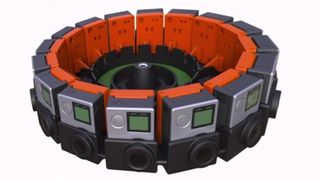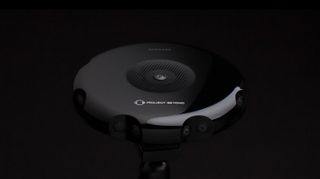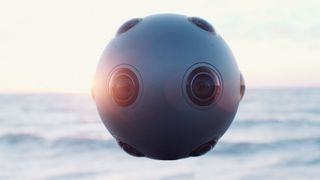These virtual reality cameras will change entertainment forever
This is the bold, beautiful future of filmmaking

Virtual reality cameras get real
The advent of virtual reality is bringing tons of new ways to experience well, pretty much anything you want.
Video games are the obvious medium for headsets like the HTC Vive, Oculus Rift or Sony's Project Morpheus but there's so much more you can do with VR. Movies are being transformed into interactive, immersive mediums and creative filmmakers are only just getting started.
Travel is another area that is catching on with companies using virtual reality to transport viewers from their living rooms to places they otherwise wouldn't be able to see in the real world.
There are also documentarians and the growing space of VR journalism using the tech as a new storytelling device to bring people closer to history as it unfolds, dropping you right into the thick of it. Similarly, live events are being shot in VR so you can watch a concert as if you've attended.
To make all this happen, innovative minds have invented even more devices to capture 360-degree environments in 3D and 360-degree sound to keep you immersed. Then comes the editing process where software is needed to stitch the scenes together with the lowest latency possible.
Additionally the battery life, proper cooling for the camera rigs to avoid overheating and video file software that isn't a pain to transfer are all issues that VR film producers must take into account.
We've highlighted a few major companies here that are making strides in creating VR tools, but keep in mind, just like virtual reality headsets that are constantly popping up out of the woodwork, tools to create for the VR world will continue to emerge and evolve as technological hurdles are overcome.

Google's 360-degree camera
Earlier this year during Google IO, a GoPro partnership was announced, along with a new camera setup for virtual reality filming.
Google said its in the midst of building and testing out Jump, a camera rig with 16 GoPro cameras mounted for a full 360-degree view, that uploads videos to YouTube.
In fact, YouTube 360 is the new platform where you'll be able to check out VR videos. It's still a work in progress but there are a few videos already on there you can watch. Expect more as time goes on, along with a shift towards higher quality.
Not much else has been revealed about the project but Google has been actively seeking out "creators" to use the camera. Though Google is mostly looking for filmmakers, artists and journalists, anyone can sign up for a chance to try out Jump.

Samsung's 360-degree camera
Samsung is another power player in the VR space. With its Oculus team up for Gear VR and Gear VR for S6, Samsung is poised as a leader in the field - at least in terms of providing quality mobile VR experiences.
Last year, the company also showed off its own camera rig system called Project Beyond.
Like Google's Jump, Beyond is comprised of 16 stereoscopic cameras and a top-view camera that 3D captures in Full HD. In all, 35MP per frame - over a gigapixel per second - can be captured and processed then streamed to Gear VR.
Beyond promises high-speed connectivity, ultra wide-angle optics, adaptive stitching and stereoscopic depth. Multiple Gear VRs can be used to connect to Project Beyond at any time, and it was stated there will be "no lag whatsoever."
Samsung notes that Beyond's defining feature is its ability to capture omniview video and stream in real time.
The camera was not touted as a commercial product and there hasn't been more information on the system since it was first announced.

Nokia's virtual reality camera
The most big name to join the 360-degree camera fray is oddly, Nokia. Thought to be floundering in a mobile phone purgatory, it was speculated that the company might actually make a comeback with some sort of VR headset of its own.
However it was revealed to be OZO - a spherical camera build that with eight synchronized global shutter sensors that capture stereoscopic 3D video, accompanied by spacial audio captured by eight integrated microphones.
Similar to Samsung's Project Beyond rig, OZO promises to stream real-time footage to VR headsets - though the headsets have yet to be specified.
Just like Jump, Nokia will be offering OZO to the public soon.

Notable VR companies to check out
With the bigger names beginning to join in earnest, creating their own pricey camera rigs, these smaller names feel more ahead of the game. With the aforementioned YouTube 360 now an option for uploading, the demand for these cameras is higher than ever. Many are releasing much more affordable - and portable - camera builds that are perfect for this generation's rabid desire for documentation.
Companies like Vrse invented its own assemblage of VR tools to create, capture and hone 360-degree footage. The end result? Beautiful short films that you can watch with Google Cardboard. Watching a Vrse produced film will definitely show the VR-uninitiated what virtual reality is all about or convince naysayers that this is the future of entertainment.
Jaunt has been around the VR block with its prototypes for the perfect VR camera. It took two years, but the recently announced camera, codenamed Neo, promises to be a high-grade rig that provides high quality, high resolution, full 360-degree capture. The company doesn't plan on selling the device, rather a rental system will be used instead. Jaunt also prefers to be known as a studio for VR rather than just a company making VR cameras.
Vrse and Jaunt are just a few teams making a splash on the VR scene. There's a growing list of companies with cameras that come in a variety of sizes, prices and availability - 360 Camera Online has amassed a solid round up - that will only get bigger.
Additionally, editing software for VR will only get better. The hardware will change and get better. Essentially, the landscape is changing and virtual reality is rapidly gaining traction, evolving in nearly every area you can think of. There's still some time in between before it really finds a stride and hits the mainstream - though we're pretty close with Oculus creator Palmer Luckey being featured on the cover of Time magazine. However, the article seems to make a farce of VR, ultimately showing that the general public is still skirting the boundaries of this new technology and hasn't quite fully arrived. But it will get there and once it happens, a new epoch of entertainment will knock everyone's socks off.
Most Popular

